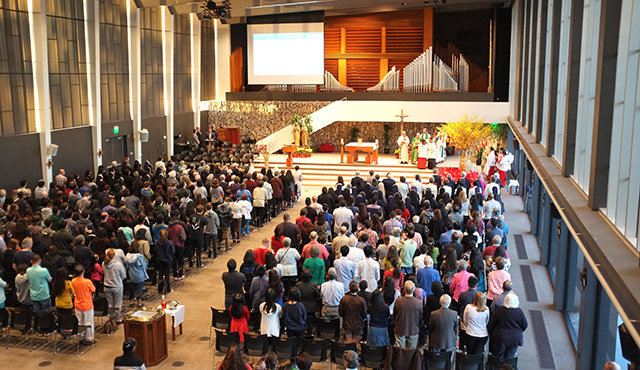Turning 40 typically causes concern for people as they approach this notorious milestone birthday. For the Roman Catholic Diocese of Orange, however, turning 40 is something to celebrate with welcome arms and unabashed pride.
In four decades, the Diocese has grown to 1.3 million Catholics (making it the 12th largest Diocese in the country) from about 300,000 – the number of Catholics who were living in O.C. on June 18, 1976.Turning 40 typically causes concern for people as they approach this notorious milestone birthday. For the Roman Catholic Diocese of Orange, however, turning 40 is something to celebrate with welcome arms and unabashed pride.
That’s the day the Diocese officially was established at a liturgical service at Holy Family Cathedral in Orange, the seat of the Diocese until 2012, when the Diocese purchased the Crystal Cathedral in Garden Grove and renamed the 34-acre campus Christ Cathedral.
For two O.C. priests who have matured along with the Diocese – the Rev. Msgr. Arthur A. Holquin, episcopal vicar for divine worship for the Diocese and pastor emeritus at Mission San Juan Basilica, and the Rev. Msgr. John Urell, pastor of St. Timothy Catholic Church in Laguna Niguel – those 40 years have gone by quickly.
“The Lord has been incredibly good to us here in the Diocese,” says Holquin, 68 and semi-retired, who on May 25 celebrated his 42nd anniversary as a priest.
“It just seems like yesterday I was ordained,” adds Holquin, describing the Diocese as “rich in talent in the level of commitment of our Catholic people.”
He adds: “We are rich in vocations, we have wonderful permanent deacons to assist our priests, and we have very large and complex multilingual parishes that place unique challenges on pastors, but that bless us in so many ways.”
Urell, 64, was in the seminary when the Diocese was established. His class was the first, in June 1978, to be ordained here. Urell worked for the Diocese for 20 years, ultimately serving as vicar general before returning to parish work, first at St. Norbert’s in Orange and, for the last nine years, at St. Timothy.
Milestones
There are too many milestones in the first four decades of the Diocese of Orange to mention here – the establishment of Christ Cathedral being one of the biggest. The Diocese has published a hardcover coffee table book detailing its 40-year history, “Call to Mission,” along with an illustrated version for younger readers.
Holquin and Urell shared what they view as a few critical developments along the journey.
Both cited the influx of Vietnamese refugees after the Fall of Saigon in 1975 as critical to shaping the size and complexion of the Diocese — both congregations and priests.
Holquin noted that founding Bishop William R. Johnson (1976-86) was instrumental in getting a number of parishes to adopt immigrant Vietnamese families, regardless of their faith.
“The biggest change, far and away, has been the change in the culture of the Diocese brought on by multiethnic groups,” says Urell, adding that when he began his priesthood English was the only language spoken at parishes.
No longer.
Vietnamese priests, for example, now account for at least a third of the Diocese’s 263 ordained priests. Masses in Vietnamese and Spanish, and sometimes Chinese, are celebrated every week at the Christ Cathedral campus.
Both monsignors noted that Johnson made it a point not to segregate parishes by ethnicities. Cultural centers, instead, were established, such as for the Korean community.
Notes Urell: “The Catholic family is one family of God.”
Holquin, who was tasked with planning the liturgical Mass to mark the founding of the Diocese, as well as many other landmark events, including the first papal visit to the West Coast by Pope John Paul II in 1987, says the Diocese is “forever grateful” for the Sisters of St. Joseph in Orange for providing space for the Diocese’s first pastoral offices.
And he cited the Diocese’s longstanding commitment to youth ministry, and the establishment by Johnson of what is now the Diocese Pastoral Service Appeal (PSA) campaign, which raises ancillary funds to support work of Diocese, as vital to the Diocese’s growth.
“The bishop was very astute at laying the foundations for the Diocese to grow,” Holquin says.
Urell noted the “wonderful role” the Diocese’s women religious have played in creating so many different ministries for the Diocese, the professionalism of lay ministry, and the commitment of all four bishops – Johnson, Norman McFarland (1987-1998), Tod Brown (1998-2012), and Kevin Vann (2012-present) – to send priests away for further study as hallmarks that make the Diocese of Orange special.
Whatever the future of the Diocese of Orange holds, one thing is certain: The Diocese, top officials say, never will waver in its mission to serve the spiritual needs of O.C. – especially those most in need.
“Our family of faith continues to follow in the footsteps laid by St. Junipero Serra so many years ago,” Bishop Kevin Vann says. “And that is, sharing the immense mercy of Christ with all we encounter and seeking to offer that mercy to the poor and vulnerable.”
-Number of Catholics: 1.3 million
-Total land area: 790 square miles
-Number of parishes: 57, plus five cultural centers
-Number of priests: 263
-Number of sisters: 291
-Schools: 32 elementary schools (diocesan, parish, private), seven high schools (diocesan and parish)

